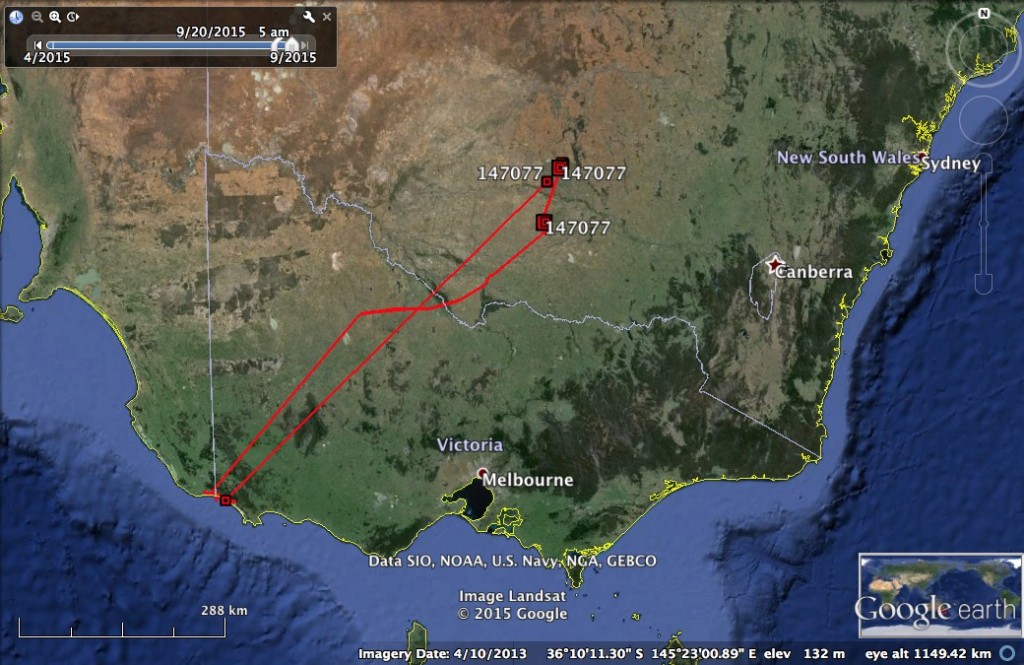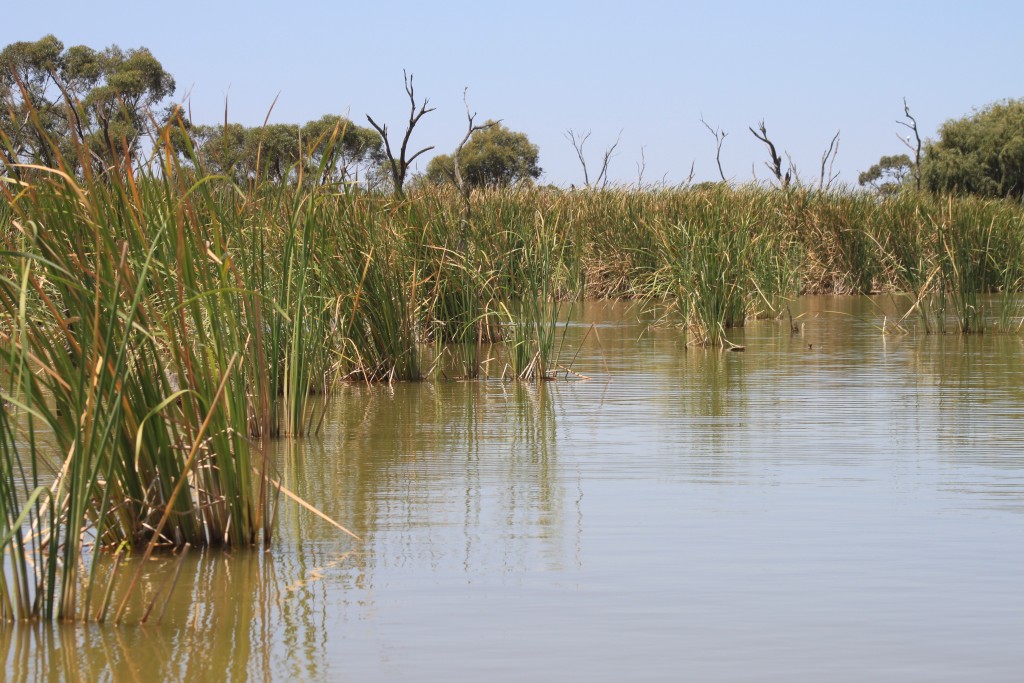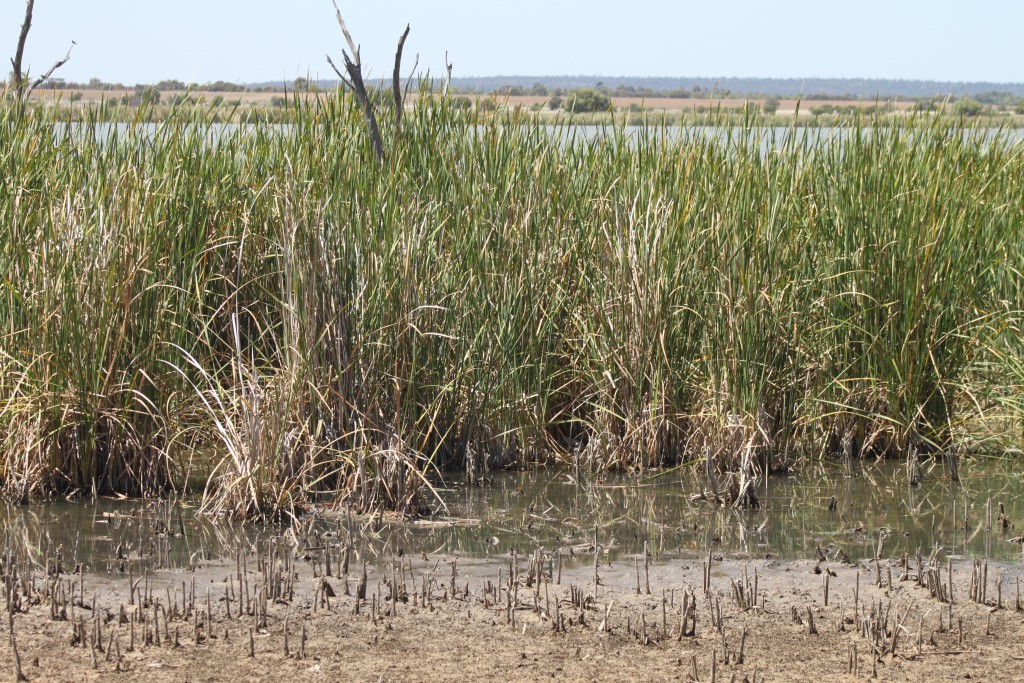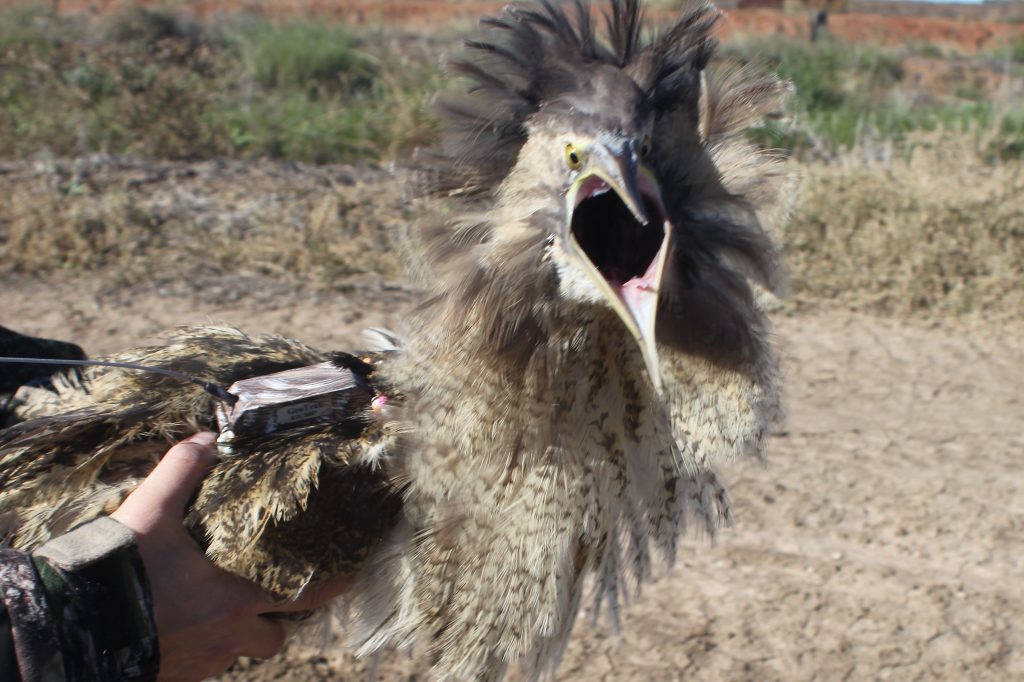The burning question burns no longer. He’s back! It was a 20-week sea change and a round trip of about 1270 kilometres. Early on Friday morning we saw that the legendary Robbie had just flown 615 km from Long Swamp near Nelson (SW Vic.) all the way to Lake Wyangan near Griffith (NSW Riverina). Remember, he was just an egg in a rice crop when the year began and a feisty youngster when we attached the satellite transmitter to him near Coleambally during rice harvest in April.
Interestingly, Lake Wyangan was one of the sites we’d searched for bitterns during the last non-breeding season because we suspected it might be part of the network of wetlands that these endangered birds rely on. We didn’t have any luck with our small sample of the extensive stands of Cumbungi around the perimeter, but in February there were Little Bitterns there and we felt like we’d barely scratched the surface. Equally interesting is that Mark Bachmann from Nature Glenelg Trust saw another Australasian Bittern at Long Swamp on Friday (clearly not Robbie), further highlighting the value of that magnificent restored wetland.
And just this morning, Robbie has appeared back in Coleambally, over 70 kilometres south of Lake Wyangan and only 12 kilometres from where we attached the transmitter!
Robbie’s journey is likely to represent a very long history of bittern movement patterns between inland wetlands (that rice crops now form an important part) and coastal wetlands. It seems his journey is best described as innate; in his bones so to speak.
But the most touching part of this story is that on Thursday night while Robbie was heading towards Lake Wyangan, a well known and greatly respected man from Yenda (also near Griffith) passed away. His name was also Robbie and with beautiful sentiment his daughter Lea said it was like her Dad was flying high. It also turns out that the late Robbie was following Robbie’s journey on our Facebook page.
 The movements of Robbie from April 21st to September 20th, 2015, covering about 1270 kilometres.
The movements of Robbie from April 21st to September 20th, 2015, covering about 1270 kilometres.
 Lake Wyangan near Griffith supports Cumbungi stands around its large perimeter.
Lake Wyangan near Griffith supports Cumbungi stands around its large perimeter.
 Lake Wyangan; the latest addition to our growing knowledge of the network of wetlands that the bittern population relies on outside of the rice growing season.
Lake Wyangan; the latest addition to our growing knowledge of the network of wetlands that the bittern population relies on outside of the rice growing season.
 Robbie: five months ago we could only speculate on the journey we were about to witness.
Robbie: five months ago we could only speculate on the journey we were about to witness.
He’s a bit early for the rice season, and especially for rice crops that are suitable for bitterns, but it’s going to be intriguing to watch his movements over the coming weeks and months as the breeding season kicks in and as the rice season progresses. Go Robbie! You’re an absolute legend.

[…] can see the full update, literally just written by Matt Herring on Robbie’s story here. What do you think, will he come back next […]
Welcome back Robbie you legend.
I wish I was there to greet him, although he wasn’t that happy with Inka and I as we released him 🙂
Great work Matt. I can’t wait to see the results of more Robbie’s.
The myth of the Bunyip along rivers may help us guess where other out of breeding locations for the annual
migrations may be. Whatever we do we will be guessing until Robbie’s peers and family show us the dispersal
patterns.
What a fantastic project. Go Coly Lion in 2016.
Thanks Terry. We’re itching to get more bitterns away with transmitters. All going well, we’ll have another three away before the end of the year and then hopefully several others before next rice harvest in autumn. You’re right, it’s presently a dangerous sample size of only one but i think it’s reasonable to assume that what we’ve seen with Robbie isn’t exceptional. It’s more or less what we predicted too. But time will tell …
What an epic journey from chick to ‘Robbie Bittern GPS Supremo’!
Do we have a ‘Bird Hall of Fame’? If so, I vote ‘Robbie Bittern’ as the inaugural member!
He deserves Legend status 🙂
Agree 100% He’s a champion.
I’ve been fascinated by the Robbie story from the beginning. Will be wonderful to get more birds in the program. So good to have the sometimes maligned rice fields involved.
Indeed, it’s a fascinating journey to witness and it will be just wonderful to get more bitterns away with satellite transmitters this summer. It’s now clear that the rice fields play a crucial role in supporting this endangered species, especially since we learnt they can breed successfully before harvest. Our project only exists because of the great support from Australian rice growers.
[…] world’s most famous bittern is on the move again. After flying 615 km from Long Swamp to Griffith last week, then 70 km to Coleambally on the weekend, he has now moved another 85 km to between […]
[…] legendary Robbie. He’s full of surprises. You’ll recall that in September he made the 600 kilometre return trip to the Riverina after spending four months at Long Swamp on the far south-west Victorian coast for his first […]
[…] and is the third member of the Tracking Bunyip Birds crew, joining Vin from yesterday and Robbie from April at the end of last […]